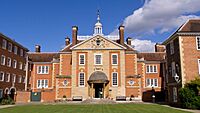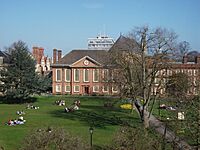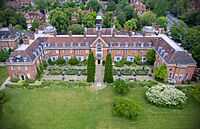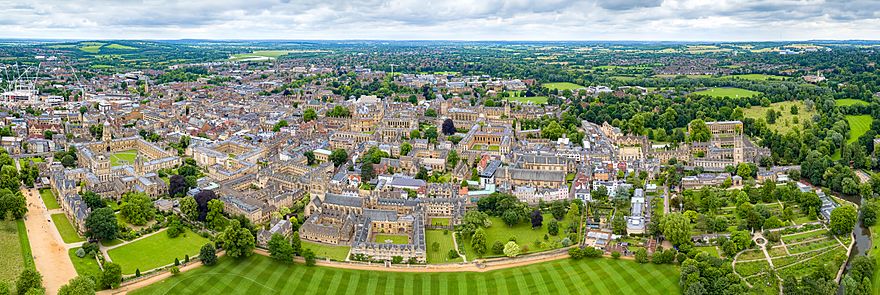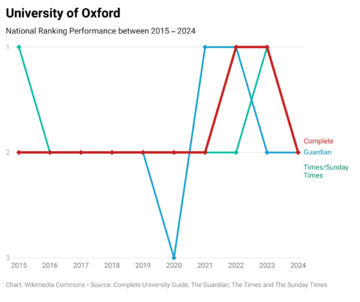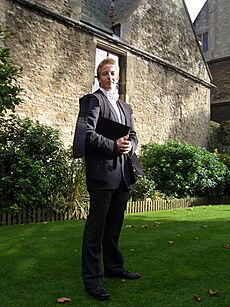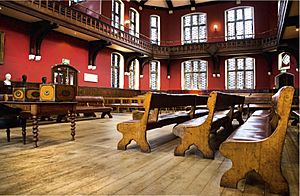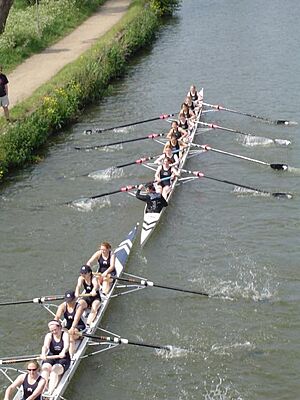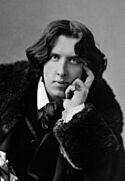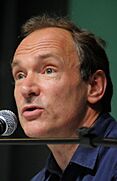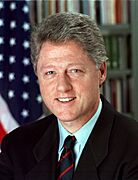University of Oxford facts for kids
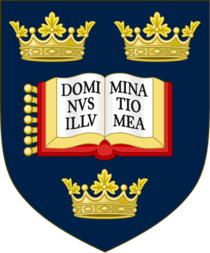
Coat of arms
|
|
| Latin: Universitas Oxoniensis | |
|
Other name
|
The Chancellor, Masters and Scholars of the University of Oxford |
|---|---|
| Motto | Dominus illuminatio mea (Latin) |
|
Motto in English
|
The Lord is my light |
| Type | Collegiate research university Ancient university |
| Established | c. 1096 |
| Endowment | £8.708 billion (2024; including colleges) |
| Budget | £3.055 billion (2023/24) |
| Chancellor | The Lord Hague of Richmond |
| Vice-Chancellor | Irene Tracey |
|
Academic staff
|
7,220 (2023/24) |
|
Administrative staff
|
8,295 (2023/24) |
| Students | (2015/16) 22,150 FTE (2015/16) |
| Undergraduates | (2015/16) |
| Postgraduates | (2015/16) |
|
Other students
|
430 (2023) |
| Location |
,
England
51°45′18″N 01°15′18″W / 51.75500°N 1.25500°W |
| Campus | University town |
| Colours | Oxford Blue |
| Affiliations |
|
 |
|
The University of Oxford is a famous university in Oxford, England. It is a "collegiate" university, meaning it has many smaller colleges that are part of it. Teaching started here as early as 1096. This makes it the oldest university in the English-speaking world. It is also the second-oldest university in the world that has been open continuously.
Oxford grew quickly from 1167. This happened when King Henry II stopped English students from going to the University of Paris. Later, some Oxford teachers moved to Cambridge in 1209. There, they started the University of Cambridge. These two old English universities are often called Oxbridge.
The University of Oxford has 43 colleges. Each college is like its own small community. It has its own rules and activities. All students at Oxford are members of a college. Oxford does not have one main campus. Its buildings are spread out across the city. Students learn through lectures, small group classes called tutorials, and lab work.
Oxford runs the Ashmolean Museum, which is the world's oldest university museum. It also has Oxford University Press, the largest university publisher. Oxford's library system is the biggest academic library system in the UK. Many famous people have studied at Oxford. This includes 31 prime ministers of the United Kingdom. As of October 2022, 73 Nobel Prize laureates have been connected to Oxford.
Contents
Oxford University's History
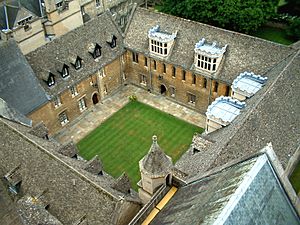
How Oxford University Started
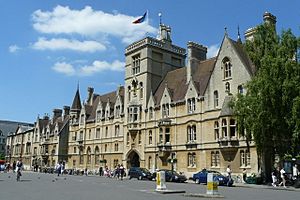
No one knows the exact date the University of Oxford began. Some historians in the 1300s thought King Alfred the Great founded it in the 800s. But this story is not true. We know that teaching was happening in Oxford by 1096. A scholar named Theobald of Étampes taught there in the early 1100s.
The university grew a lot starting in 1167. This was because King Henry II ordered English students to leave the University of Paris. Many scholars came back to Oxford, making it a busy place for learning. The head of the university was called the chancellor by 1201. The university officially became a "corporation" in 1231. King Henry III gave it a special royal charter in 1248.
After some fights between students and local people in 1209, some teachers left Oxford. They went to Cambridge and later started the University of Cambridge. Students at Oxford used to group themselves by where they came from. There were "northerners" and "southerners." Later, colleges became the main way students belonged to a group. Many religious groups also set up houses for students in Oxford.
Around the same time, wealthy people started building colleges. These were self-contained places for scholars. William of Durham helped start University College in 1249. John Balliol helped start Balliol College. Another founder, Walter de Merton, created rules for college life. His college, Merton College, became a model for other colleges at Oxford and Cambridge.
In the 1330s, some unhappy Oxford scholars tried to start a new university. They wanted to build it in Stamford, Lincolnshire. But Oxford and Cambridge asked King Edward III to stop them. He did. Because of this, no new universities were allowed in England until the 1820s. This meant Oxford and Cambridge were the only two universities for a long time.
Oxford in the Renaissance
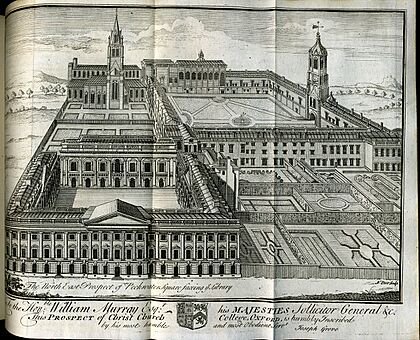
The new ideas of the Renaissance greatly changed Oxford from the late 1400s. Scholars like William Grocyn helped bring back the study of Greek language. John Colet was a famous Bible scholar.
When England broke away from the Roman Catholic Church (the English Reformation), some Oxford scholars left. They went to Europe, especially to the University of Douai. Oxford's teaching style changed from old medieval ways to Renaissance education. However, the university also lost some land and money. During the Age of Enlightenment, Oxford's reputation for learning went down. Fewer students enrolled, and teaching was not as good.
In 1636, William Laud, the university's chancellor, wrote down its rules. These rules guided the university until the mid-1800s. Laud also helped the Oxford University Press get special rights. He also made important gifts to the Bodleian Library. For a long time, until 1866, you had to be a member of the Church of England to get a Bachelor of Arts degree.
Oxford was a center for the King's supporters (Royalists) during the English Civil War (1642–1651). The town itself supported the Parliament.
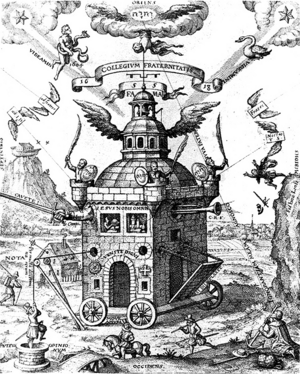
Wadham College, founded in 1610, was where Sir Christopher Wren studied. He was part of a group of scientists in Oxford in the 1650s. This group included Robert Boyle and Robert Hooke. They met regularly and later helped start the Royal Society.
Modern Times at Oxford
Changes for Students
In 1827, Oxford reviewed its old rules. One change was removing a strange rule. Students no longer had to promise to hate a local man named Henry Symeonis. He was found guilty of killing an Oxford student in the 1200s.
Before the 1800s, Oxford's courses were very narrow. They were not very practical. A historian named Spencer Walpole said that few people going into medicine or business studied at a university. He quoted a report from 1852. It said Oxford's education mostly helped those who wanted to become church ministers.
However, Walpole also said that students learned a lot from each other. Being with many bright young people helped them learn loyalty and self-control. Even if they didn't learn much from books, they learned about people. They gained respect for others and themselves. This helped them later in life.
In 1840, most students (65%) were sons of professionals. After graduating, 87% became professionals. Many became Anglican clergy. By 1870, 59% were sons of professionals. After graduation, 87% still became professionals, but fewer became clergy.
Organized sports became very popular at Oxford and Cambridge in the late 1800s. This came from the sports culture in famous schools like Eton.
All students used to have to study classical languages in their first year. Science students found this difficult. They wanted a separate science degree without Greek. Other European universities had science degrees. But Oxford's idea to replace classics with a modern language failed in 1880. Finally, in 1886, a "natural science preliminary" was accepted as part of the first-year exam.
Before World War I (1914), Oxford had about 3,000 undergraduate students. During the war, many students and teachers joined the army. By 1918, most teachers were serving. The number of students dropped to only 12% of what it was before the war. Over 14,792 members of the university served. Sadly, 2,716 (18.36%) were killed. During the war, university buildings were used as hospitals and training camps.
University Reforms
Two government groups in 1852 suggested changes for Oxford and Cambridge. They wanted Oxford to focus more on research and professors. They said professors should be stronger and paid better. They also wanted to make it easier for poorer students to get in. They suggested adding more subjects and opening scholarships to all British students. They also said teachers should not have to become priests. Students should be allowed to live in the city to save money.
New ways of getting honors degrees for different subjects started in 1802. These included Mathematics and Classics. "Natural Sciences" and "Law, and Modern History" were added in 1853. Later, Law and Modern History became separate. Theology became the sixth honors subject.
The mid-1800s also saw the Oxford Movement. This was a religious movement led by people like John Henry Newman. In the 1800s, Oxford also made administrative changes. They started using written entrance tests instead of oral ones. They became more accepting of different religious groups. They also started four women's colleges. Over time, the university became less tied to traditional religious beliefs. While Oxford used to focus on classical knowledge, it added science and medical studies in the 1800s.
New postgraduate degrees were introduced in 1895. These were Bachelor of Science and Bachelor of Letters. They were later renamed Master of Science and Master of Letters in the 1970s. Oxford started giving out doctorates for research in 1900. The first Doctor of Philosophy degree (DPhil) was introduced in 1917. It was first given in 1919 to Lakshman Sarup.
Women's Education at Oxford
In 1875, Oxford allowed women to take exams. These exams were similar to undergraduate studies. In 1878, a group called the Association for the Education of Women (AEW) was formed. They wanted to create a college for women in Oxford. Two groups formed from this. One group started Lady Margaret Hall in 1878. The other group started Somerville College in 1879.
Lady Margaret Hall and Somerville opened in 1879 with 21 female students. These students attended classes in rooms above a bakery. Other women students lived at home. This group later became St Anne's College. Two more women's colleges followed: St Hugh's (1886) and St Hilda's (1893).
All these colleges later started accepting both male and female students. Lady Margaret Hall and St Anne's were first in 1979. St Hilda's was last, accepting male students in 2008. In the early 1900s, Oxford and Cambridge were mostly for men. But during World War I, women's roles at Oxford grew. By 1916, women could study medicine like men.
On October 7, 1920, women could become full members of the university. They also gained the right to earn degrees. In 1927, the university limited the number of female students. They could only be one-quarter the number of men. This rule was removed in 1957. Also, colleges were only for one gender. So, the number of women was limited by how many women's colleges there were. Women's colleges got full college status in 1959.
In 1974, five colleges that were only for men started accepting women. These were Brasenose, Jesus, Wadham, Hertford, and St Catherine's. Most men's colleges accepted women in 1979. Christ Church followed in 1980. Oriel was the last men's college to accept women in 1985. Most graduate colleges were started for both genders in the 1900s. By 1988, 40% of Oxford's undergraduate students were female. In 2016, 45% of all students were female.
In June 2017, Oxford announced a change for history students. They could choose to take a take-home exam for some courses. This was to help more women get top grades. That same summer, math and computer science tests were made 15 minutes longer. This was to see if female students' scores would get better.
The detective novel Gaudy Night by Dorothy L. Sayers is set in a fictional women's college at Oxford. Sayers herself studied at Somerville College. The book talks a lot about women's education.
Oxford's Buildings and Places
Map of Oxford University
| Map of the University of Oxford | |||||||||||
|---|---|---|---|---|---|---|---|---|---|---|---|
|
|||||||||||
Main University Sites
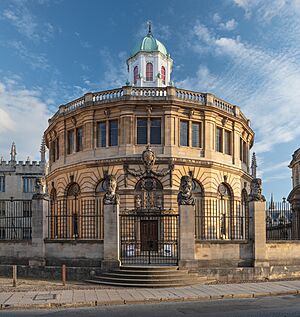
Oxford is a "city university." This means it doesn't have one main campus. Instead, its colleges, departments, and other buildings are spread throughout Oxford city. The Science Area is where most science departments are. This area looks the most like a campus. There is also a ten-acre area called the Radcliffe Observatory Quarter in the northwest of the city.
Famous university buildings include the Radcliffe Camera. This is a beautiful library building. The Sheldonian Theatre is used for concerts, lectures, and graduation ceremonies. The Examination Schools are where exams and some lectures happen. The University Church of St Mary the Virgin was used for university ceremonies before the Sheldonian was built.
In 2012–2013, the university built the Castle Mill student flats. These buildings are 4–5 stories tall. They overlook Cripley Meadow and the historic Port Meadow. Some people thought they blocked views of the city's spires.
Parks and Gardens
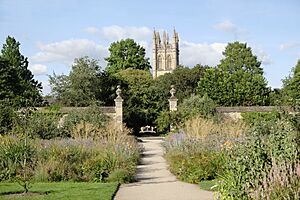
The University Parks are a large park area (70 acres) in the northeast of the city. They are near colleges like Keble and Somerville. The parks are open to the public during the day. Many colleges also have open spaces that are open to the public. A notable one is Christ Church Meadow.
The Botanic Garden is on the High Street. It is the oldest botanic garden in the UK. It has over 8,000 different plant species on 1.8 hectares. It is one of the most diverse plant collections in the world. The Harcourt Arboretum is a 130-acre site south of the city. It has native woodland and meadows. The 1000-acre Wytham Woods are owned by the university. They are used for research on animals and climate change.
How Oxford University Works
Colleges arrange the tutorial teaching for their undergraduate students. Teachers from academic departments are spread across many colleges. Some colleges focus on certain subjects, like Nuffield College for social sciences. But most colleges have students and teachers from many different subjects. Libraries are available at all levels: the main university library (the Bodleian), departmental libraries, and college libraries.
How the University is Run
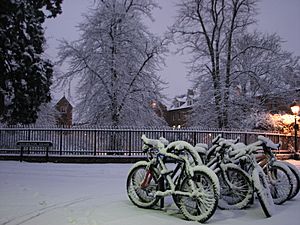
The official head of the university is the chancellor. Currently, Lord Hague of Richmond is expected to take this role in early 2025. However, like in most British universities, the chancellor is a ceremonial figure. They are not involved in the daily running of the university. The chancellor is chosen by all university graduates. They can hold the job for life.
The vice-chancellor, currently Irene Tracey, is the actual head of the university. There are also five pro-vice-chancellors who have specific jobs.
Two university proctors are chosen each year from two different colleges. They act as internal problem-solvers. They make sure the university and its members follow the rules. This includes student behavior and complaints. The university's professors are known as the Statutory Professors. They have a lot of influence in running the university's graduate programs.
Oxford is a "public university" because it gets some money from the government. But it is also a "private university" because it runs itself. In theory, it could choose to be fully private by not taking public money.
Oxford's Colleges
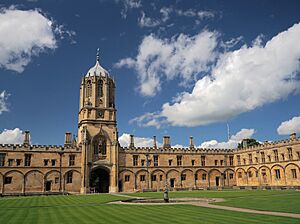

To be a student or staff member at Oxford, you must also belong to a college or hall. There are 39 colleges of the University of Oxford and four permanent private halls (PPHs). Each college decides who joins it. They also have their own rules and activities. Most colleges offer a wide range of subjects.
The 39 colleges are:
 All Souls
All Souls Balliol
Balliol Brasenose
Brasenose Christ Church
Christ Church Corpus Christi
Corpus Christi Exeter
Exeter Green Templeton
Green Templeton Harris Manchester
Harris Manchester Hertford
Hertford Jesus
Jesus Keble
Keble Kellogg‡
Kellogg‡ Lady Margaret Hall
Lady Margaret Hall Linacre
Linacre Lincoln
Lincoln Magdalen
Magdalen Mansfield
Mansfield Merton
Merton New College
New College Nuffield
Nuffield Oriel
Oriel Pembroke
Pembroke The Queen's
The Queen's Reuben‡
Reuben‡ Somerville
Somerville St Anne's
St Anne's St Antony's
St Antony's St Catherine's
St Catherine's St Cross‡
St Cross‡ St Edmund Hall
St Edmund Hall St Hilda's
St Hilda's St Hugh's
St Hugh's St John's
St John's St Peter's
St Peter's Trinity
Trinity University
University Wadham
Wadham Wolfson
Wolfson Worcester
Worcester
‡ These three colleges do not have a royal charter. They are officially departments of the university.
The four permanent private halls (PPHs) were started by different Christian groups. Unlike colleges, PPHs are partly run by their Christian denomination. The four PPHs are:
 Blackfriars Hall
Blackfriars Hall Campion Hall
Campion Hall Regent's Park
Regent's Park Wycliffe Hall
Wycliffe Hall
The PPHs and colleges work together in the Conference of Colleges. This group discusses shared interests and acts together when needed. Teachers in the colleges are often called "dons." Colleges provide places to live, eat, and do social activities. They are also in charge of admitting undergraduate students and organizing their teaching. For graduate students, the university departments handle admissions.
How Oxford University is Funded
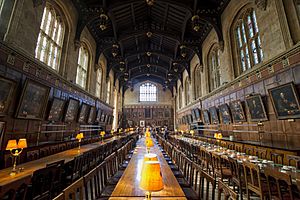
| Financial year ending 31 July | ||
|---|---|---|
| 2024 | 2023 | |
| Total group income of the University (excluding colleges) | 3.054 | 2.829 |
| Total expenditure during the year | 2.263 | 2.581 |
| Key sources of income | ||
| Tuition fees and education contracts | 0.551 | 0.5042 |
| Grants from funding bodies | 0.2247 | 0.2292 |
| Research grants and contracts | 0.7789 | 0.789 |
| Publishing services | 0.7468 | 0.753 |
| Investment income | 0.1972 | 0.1805 |
| Donations and endowments | 0.238 | 0.1869 |
| Assets at year end | ||
| University endowments (excluding colleges) | 1.912 | 1.678 |
| Total net assets | 6.388 | 5.385 |
| Total College endowments | 6.796 | 6.388 |
| Total college net assets | 8.738 | 8.176 |
Oxford has the largest endowment of any UK university. An endowment is money given to the university to invest. The total is £8.708 billion. This figure for colleges does not include the value of their main buildings or art.
The university's own endowment is managed by Oxford University Endowment Management. This office was created in 2007. In April 2020, the university decided to stop investing directly in fossil fuel companies.
Oxford was one of the first UK universities to raise money through a big public campaign. Its current campaign, "Oxford Thinking," started in May 2008. It aims to support academic programs, students, and buildings. It passed its original goal of £1.25 billion in March 2012. The new goal is £3 billion.
Concerns about Funding
The university has faced some questions about where its donations come from. For example, in 2017, people noted old donations. All Souls College received £10,000 in 1710 from a slave trader. Oriel College received £100,000 in 1902 from an imperialist. The university has said it considers legal, ethical, and reputation issues when accepting money.
Oxford also faced criticism for taking money from fossil fuel companies. It received millions from this industry between 2010 and 2021.
In 2021, the university accepted £6 million from The Alexander Mosley Charitable Trust. This trust was set up by Max Mosley. He said it held money he inherited from his father, Oswald Mosley. Oswald Mosley founded far-right groups.
University Connections
Oxford is a member of the Russell Group. This is a group of leading research universities in the UK. It is also part of the "golden triangle" of top universities in South East England. Internationally, Oxford is part of groups like the League of European Research Universities.
Academic Life at Oxford
How to Get into Oxford
| 2023 | 2022 | 2021 | 2020 | 2019 | |
|---|---|---|---|---|---|
| Applications | 23,211 | 23,819 | 24,338 | 23,414 | 23,020 |
| Offer Rate (%) | 16.0 | 15.3 | 14.6 | 16.8 | 16.9 |
| Enrolments | 3,219 | 3,271 | 3,298 | 3,695 | 3,280 |
| Yield (%) | 86.5 | 89.7 | 92.8 | 94.0 | 84.3 |
| Applicant/Enrolled Ratio | 7.21 | 7.28 | 7.38 | 6.34 | 7.02 |
| Average Entry Tariff | N/A | 202 | 205 | 201 | 200 |
| Domicile and Ethnicity | Total | ||
|---|---|---|---|
| British White | 46% |
|
|
| British Ethnic Minorities | 18% |
|
|
| International EU | 8% |
|
|
| International Non-EU | 28% |
|
|
| Undergraduate Widening Participation Indicators | |||
| Female | 53% |
|
|
| Independent School | 31% |
|
|
| Low Participation Areas | 7% |
|
|
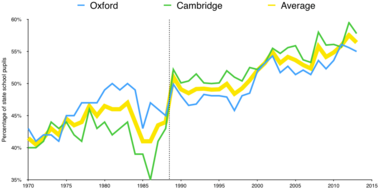
Students who want to study at Oxford apply through the UCAS system. But they must apply earlier than for most other universities, by October 15. The Sutton Trust says that Oxford and Cambridge accept a lot of students from just 8 schools.
You cannot apply to both Oxford and Cambridge in the same year. This is to help students choose. The only exceptions are for certain scholarships or if you are applying for a second degree. Oxford has one of the lowest offer rates among top UK universities.
Most students apply to a specific college. But the colleges work together to make sure good students get a place at the university. This happens even if their first choice college is full. Graduate students who are accepted by the university are guaranteed a place in a college.
To get into Oxford, your past and predicted exam results are important. So are school references. For some subjects, you might take a written test or submit written work. About 60% of applicants are chosen for the next stage. If too many students choose one college, some might be moved to another college. Then, colleges invite chosen students for interviews. These interviews happen in December. Most students are interviewed by teachers at more than one college. Since 2020, interviews have been online. They will stay online until at least 2027.
Offers to study at Oxford are sent out in early January. Usually, the offer is from a specific college. About one in four successful students gets an offer from a college they did not apply to. Some courses might give "open offers." These students are not assigned to a college until their exam results come out in August.
Oxford has been criticized for accepting many students from private schools. For example, in 2000, a student named Laura Spence was rejected. This led to a big debate. In 2016, 59% of offers to UK students went to state school students. About 93% of all UK students go to state schools. However, Oxford says that state school students often apply to very popular subjects. The number of state school students has been growing. Oxford spends over £6 million each year on programs to encourage students from all backgrounds to apply.
In 2018, a report showed that eight Oxford colleges had accepted fewer than three Black students in three years. A politician named David Lammy said this was "social apartheid." In 2020, Oxford increased its number of Black, Asian, and Minority Ethnic (BAME) students. The number of BAME undergraduates accepted rose to 684 students. This was 23.6% of the UK intake. The number of Black students was 106 (3.7% of the intake). Data also showed that Oxford is more likely to offer places to ethnic minority and less privileged students.
How Oxford Teaches and Awards Degrees
Undergraduate teaching at Oxford mainly happens in tutorials. In a tutorial, 1–4 students spend an hour with a teacher. They discuss their work for the week. This is usually an essay or a problem sheet. The university itself is in charge of exams and giving out degrees. Undergraduate teaching takes place during three eight-week terms. These are called Michaelmas, Hilary, and Trinity. These terms are shorter than at most other British universities. But students are expected to study during the holidays too.
Scholarships and Financial Help

There are many ways for students at Oxford to get financial help. The Oxford Opportunity Bursaries started in 2006. These are university-wide grants for British undergraduate students. They are based on how much money a student's family has. A student can get up to £10,235 over a three-year degree. Colleges also offer their own grants to help students.
For graduate studies, there are many scholarships. These are for students from all backgrounds. Examples include the Rhodes Scholarship and the newer Weidenfeld Scholarships. Oxford also offers the Clarendon Scholarship. This is open to graduate students from any country. It is mainly funded by Oxford University Press.
Students who do well in early exams can get scholarships from their colleges. These are usually small amounts of money today. But in the past, they were more significant. Students with scholarships can wear a special, larger gown. Other students wear a shorter gown. The word "scholar" at Oxford means someone who has won one of these awards. It also means someone who is very good at academics.
Oxford's Libraries

Oxford has the largest university library system in the UK. The Bodleian group of libraries has over 11 million books. This makes it the second-largest library in the UK, after the British Library. The Bodleian is a "legal deposit" library. This means it can ask for a free copy of every book published in the UK. Because of this, its collection grows by over five kilometers of shelving every year.
The main research library, The Bodleian, includes the original Bodleian Library. This was founded by Sir Thomas Bodley in 1598. It opened in 1602. It also includes the Radcliffe Camera, the Clarendon Building, and the Weston Library. A tunnel under Broad Street connects these buildings. The Gladstone Link, opened in 2011, connects the Old Bodleian and Radcliffe Camera.
The Bodleian Libraries group was formed in 2000. It brought together the Bodleian Library and some subject libraries. It now has 28 libraries. Many of these were created by combining older collections. Examples include the Sackler Library and the Law Library. They also have a shared electronic catalog system called SOLO. This system covers all member libraries and college libraries.
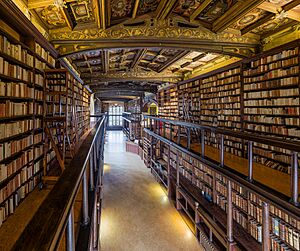
A new book storage facility opened in Swindon in October 2010. Recent building projects include updating the New Bodleian building. It was renamed the Weston Library when it reopened in 2015. This renovation helps show off the library's treasures. These include a Shakespeare First Folio and a Gutenberg Bible.
The Bodleian started a large project with Google in 2004 to digitize books. The Bodleian Group also hosts important online resources. One is the Electronic Enlightenment Project.
Oxford's Museums

Oxford has several museums and galleries. They are open to the public for free. The Ashmolean Museum, founded in 1683, is the oldest museum in the UK. It is also the oldest university museum in the world. It has important collections of art and archaeology. These include works by Michelangelo and Leonardo da Vinci. It also has treasures like the Alfred Jewel.
The University Museum of Natural History holds animal, insect, and rock specimens. It is in a large Gothic-style building on Parks Road. Its collection includes skeletons of a Tyrannosaurus rex and Triceratops. It also has the most complete remains of a dodo found anywhere.
Next to the Museum of Natural History is the Pitt Rivers Museum. It was founded in 1884. It shows the university's archaeology and anthropology collections. It has over 500,000 items. Its staff have taught anthropology at Oxford since it started.
The Museum of the History of Science is on Broad Street. It is in the world's oldest building made specifically for a museum. It has 15,000 items from ancient times to the 1900s. These show almost all parts of the history of science. The Bate Collection of Musical Instruments is in the Faculty of Music. It has many instruments from Western classical music. The Christ Church Picture Gallery has a large collection of old paintings and drawings.
Publishing at Oxford
The Oxford University Press is the world's second oldest university publisher. It is also the largest by the number of books it publishes. It publishes over 6,000 new books each year. These include reference books, professional books, and academic works. Famous examples are the Oxford English Dictionary and the Oxford World's Classics.
Oxford's Reputation and Rankings
| National rankings | |
|---|---|
| Complete (2021) | 2 |
| Guardian (2021) | 1 |
| Times / Sunday Times (2021) | 3 |
| Global rankings | |
| ARWU (2020) | 6 |
| QS (2021) |
4 |
| THE (2021) | 1 |
Because of its age and academic standing, Oxford is seen as one of Britain's most important universities. It is often grouped with the University of Cambridge as the top two in the UK.
Oxford is usually ranked among the top five universities in the world. This is according to the Times Higher Education World University Rankings and Forbes rankings. It was ranked number one in the Times Good University Guide for eleven years in a row. Its medical school has been first in the "Clinical, Pre-Clinical & Health" table for seven years. In 2021, it was ranked sixth globally by SCImago Institutions Rankings. The THE also calls Oxford one of the world's "six super brands."
Oxford was ranked 13th in the world in 2022 by the Nature Index. This index looks at contributions to leading science journals. It is ranked fifth best university worldwide for training CEOs. It is also first in the UK for the quality of its graduates, as chosen by major UK companies.
In the 2018 Complete University Guide, all 38 subjects offered by Oxford were in the top 10 nationally. Computer Science, Medicine, Philosophy, Politics, and Psychology were ranked first in the UK.
According to the QS World University Rankings by Subject, Oxford is number one globally for four Humanities subjects. These are English Language and Literature, Modern Languages, Geography, and History. It also ranks second globally for Anthropology, Archaeology, Law, Medicine, Politics & International Studies, and Psychology.
Student Life at Oxford
Traditions at Oxford
Students must wear special academic clothes, called subfusc, for exams and other official events. In 2015, students voted against making it optional for exams. This showed that most students wanted to keep the tradition. In July 2012, the rules for academic dress were changed to be more welcoming to transgender people.
"Trashing" is a tradition where students spray friends with alcohol, flour, and confetti after their last exam. The student wears their academic dress during this. This custom started in the 1970s. Other traditions vary by college. Some colleges have "formal hall" dinners often. Others have them only sometimes. "Balls" are big parties held by colleges. The largest ones are called commemoration balls. People usually wear white tie formal wear.
Clubs and Student Groups
The Oxford Union is an independent debating society. It holds weekly debates and invites famous speakers. There are also political groups like the Oxford University Conservative Association. Most academic subjects have student societies.
There are two weekly student newspapers: Cherwell and The Oxford Student. Other publications include the Isis magazine and the funny Oxymoron. The student radio station is Oxide Radio.
Sports are played between college teams in competitions called "cuppers." Rowing is very popular. There are termly intercollegiate rowing races like Torpids and Summer Eights. There are also higher-level university teams. A lot of attention is given to annual matches against Cambridge. The most famous is The Boat Race, watched by millions on TV. A "blue" is an award for students who play at the university team level in certain sports.
Music, drama, and other arts groups exist in colleges and across the university. Examples include the Oxford University Dramatic Society. Most colleges have choirs. The Oxford Imps are a comedy group that performs weekly.
There are also private clubs for students. These include Vincent's Club for sportspeople. Some invitation-only student dining clubs exist, like the Bullingdon Club.
Student Union and Common Rooms
The Oxford University Student Union, now called Oxford SU, represents students. It speaks for students in university decisions and national education debates. It also provides services to students. Oxford SU is made up of individual students and college common rooms.
College life is very important to many students. For them, their college's JCR (Junior Common Room for undergraduates) or MCR (Middle Common Room for graduates) is more important than Oxford SU. JCRs and MCRs have committees with elected students. These students represent their peers to college leaders. They also organize events and have budgets to spend.
Famous People Who Studied at Oxford
Many Oxford alumni, known as Oxonians, have become famous in many fields. More than 70 Nobel Prize winners have studied or taught at Oxford. They have won prizes in all six categories. You can find more information about famous members in the individual college articles. A person might be linked to more than one college. For example, they might have been an undergraduate, a graduate student, or a staff member.
Famous alumni include three Fields Medallists (for mathematics). Two British kings and at least fifteen monarchs from other countries also studied here. Twenty-eight British prime ministers and thirty-five presidents and prime ministers from other countries are Oxford alumni. As of July 2019, seven Oxonians were in the UK Cabinet.
The university has produced 291 Members of Parliament. It also produced many judges and politicians in the US and Canada.
Oxford in Books and Movies
The University of Oxford is often featured in stories. Chaucer mentioned an "Oxford student" in his Canterbury Tales around 1400. One of the first novels set at a university was The Adventures of Oxymel Classic, Esq; Once an Oxford Scholar (1768). By 1900, many novels were written about Oxford and Cambridge. By 1989, over 533 novels set in Oxford had been found.
Famous books include Brideshead Revisited by Evelyn Waugh. This book was made into a TV show in 1981. The His Dark Materials trilogy by Philip Pullman features a different version of the university. It was made into a film in 2007 and a BBC TV series in 2019.
Other notable examples include:
- Zuleika Dobson (1911) by Max Beerbohm, a funny story about student life.
- Gaudy Night (1935) by Dorothy L. Sayers, a mystery novel.
- The Inspector Morse detective novels (1975–1999) by Colin Dexter. These were made into the TV series Inspector Morse (1987–2000). There were also spin-offs like Lewis (2006–2015) and Endeavour (2012–2023).
- True Blue (1996), a film about a rowing team mutiny during the Oxford-Cambridge Boat Race of 1987.
- The History Boys (2004) by Alan Bennett, a play about schoolboys applying to Oxford and Cambridge. It was made into a film in 2006.
- Posh (2010), a play by Laura Wade, and its film The Riot Club (2014). These are about a fictional club similar to the Bullingdon Club.
- Testament of Youth (2014), a drama film based on the book by Vera Brittain.
A notable non-fiction book about Oxford is Oxford by Jan Morris.
See also
 In Spanish: Universidad de Oxford para niños
In Spanish: Universidad de Oxford para niños
- Academic scarves of the University of Oxford
- Gaudy celebrations
- List of medieval universities
- List of University of Oxford people
- May Morning celebration
- Oxford "-er"
- Oxford bags
- Oxford University (UK Parliament constituency)
- Oxford University Police
- Town and gown
- University of Oxford tortoises



